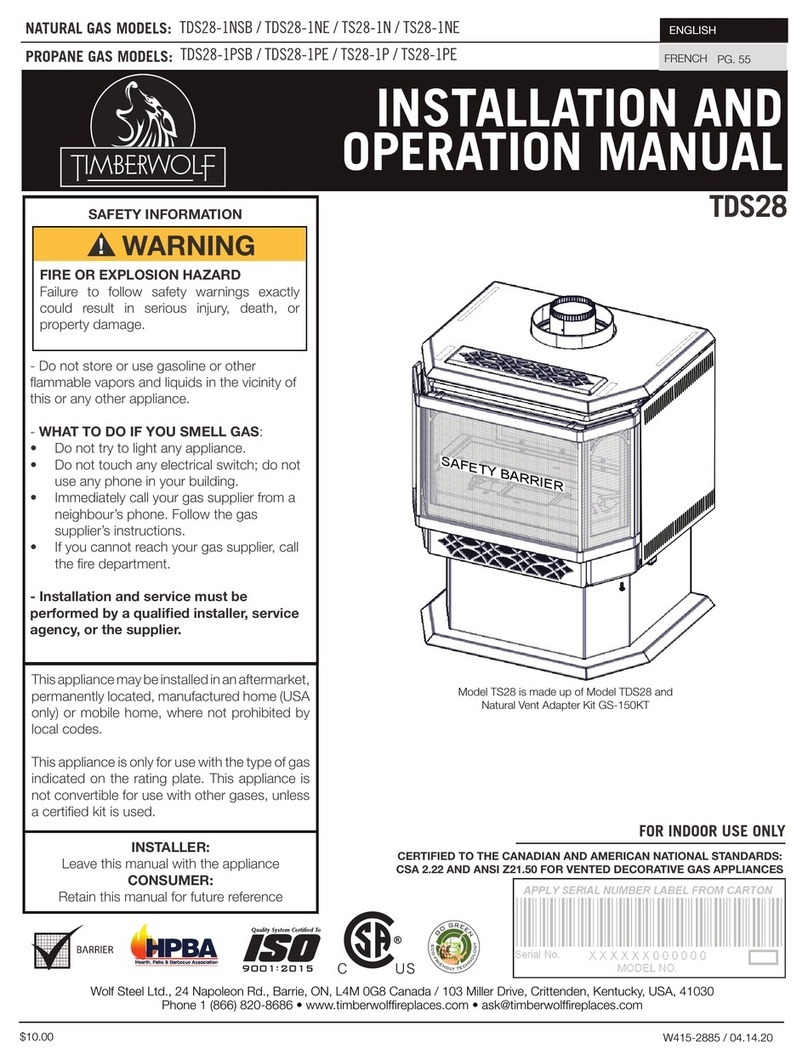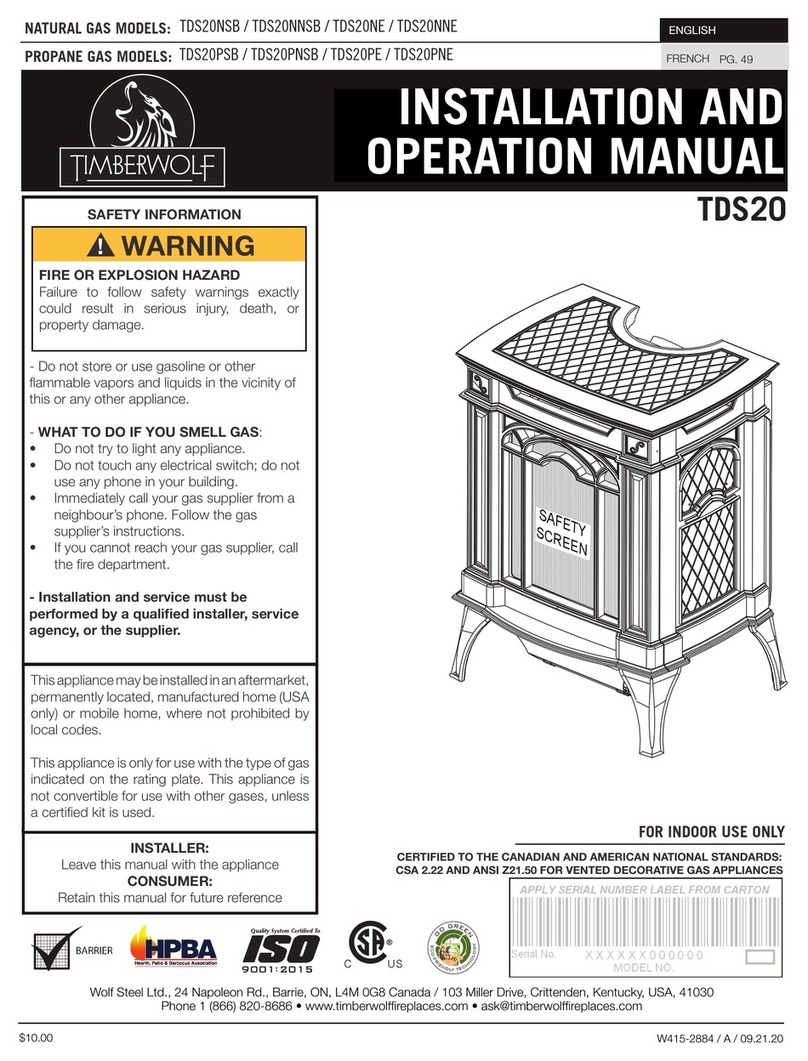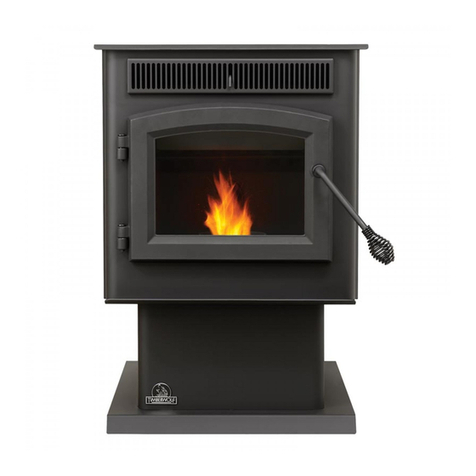
W415-1473 / 04.22.15
EN
7
Expansion / contraction noises during heating up and cooling down cycles are normal and to be expected.
After extended periods of non-operation such as following a vacation or a warm weather season, the appliance may
emit a slight odour for a few hours. This is caused by dust particles on the firebox burning off. Open a window to
sufficiently ventilate the room.
CALIFORNIA PROP 65 WARNING:
Use of this product may produce smoke which contains chemicals
known to the State of California to cause cancer, birth defects, or other
reproductive harm.
If optional ash drawer is purchased, ensure that the ash dump door is
tightly closed, allow the door to snap shut dislodging anything (ashes or
pieces of coal) that may be stuck in the opening.
If outside air is utilized, you should never experience a shortage of combustion air. If you choose not to utilize
outside air and experience draft or smoking problems, you may need to open a door, a window or otherwise provide
some method of supplying combustion air to the appliance.
2.5 RATING PLATE INFORMATION
For rating plate location, see
“INSTALLATION OVERVIEW”
section.
This illustration is for reference
only. Refer to the rating plate on the
appliance for accurate information.
8" 8"
18"
8"
C
BACK WALL (M/A)
45°
SIDE WALL (M/L)
FROM HEATER / DU POÊLE
RESIDENTIAL / RÉSIDENTIEL
A. 22IN/PO (560 mm)
B. 12IN/PO (305mm)
C. 8IN/PO (205mm)
BACK WALL (M/A)
SIDE WALL (M/L)
B
A
IF THE STOVE IS TO BE INSTALLED ON ACOMBUSTIBLE FLOOR, IT
MUST BE PLACED ON ANAPPROVED NON-COMBUSTIBLE HEARTH
PAD, THAT EXTENDS 8” (200MM) BEYOND THE STOVE SIDES AND
BACK, AND 18” (455MM) TO THE FRONT.
SI LE PO
Ê
LE EST INSTALL
É SUR UN PLANCHER COMBUSTIBLE, IL DOIT
ÊTRE PLACÉ SUR UNE BASE DE PROTECTION INCOMBUSTIBLE CERTIFÉE
QUI DOIT DÉPASSER LES CÔTÉS ET L’AMÉRE DU
PO
Ê
LE DE 8” (200mm)
ET SE PROLONGER DE 18” (455mm) SUR LE DEVANT.
MINIMUM CLEARANCE TO COMBUSTIBLE MATERIAL USING SINGLE
OR DOUBLE WALLCHIMNEY CONNECTORS / DÉGAGEMENT
MINIMALAUX MATÉRIAUX COMBUSTIBLEAVEC DES CONDUITS DE
RACCORDEMENT À PAROI SIMPLE OU À DOUBLE PAROI
CONTACT LOCAL BUILDING FIRE OFFICIALSABOUT RESTRICTIONS
AND INSTALLATION INSPECTIONS INYOUR LOCALAREA. AMINIMUM
CLEARANCE OF 18 INCHES (457mm) TO THE CHIMNEY CONNECTOR
MAY BE REQUIRED BY THEAUTHORITY HAVING JURISDICTION.
RENSEIGNEZ-VOUS AUPRÈS DESAUTORITÉS LOCALES DU
BÂTIMENT ET DU SERVICE DES INCENDIESAU SUJET DES
RESTRICTIONS ET DES INSPECTIONS D’INSTALLATION DANS VOTRE
RÉGION. UN DÉGAGMENT MINIMAL DE 18 POUCES (457mm)
JUSQU’AU RACCORD DE LA CHEMINÉE PEUT ÊTRE EXIGÉ PAR
L’AUTORITÉ AYANT JURIDICTION.
INSTALLAND USE ONLYIN
ACCORDANCE WITH THE
MANUFACTURER’S INSTRUCTIONS
AND LOCAL BUILDING CODES.
MINIMUM CEILING HEIGHT: 7FT
(2.13m)
HEARTH EXTENSION / COMBUS-
TIBLE FLOOR PROTECTION: IF
INSTALLED ON ACOMBUSTIBLE
FLOOR, UNIT MUST BE PLACED ON
A NON-COMBUSTIBLE FLOOR
PROTECTOR EXTENDING 18”
(455mm) IN FRONT AND 8” (205mm)TO
THE SIDES AND BACK.
CHIMNEY TYPE: MINIMUM 6”
(152mm) DIAMETER APPROVED
RESIDENTIAL TYPE FOR MOBILE
HOME USE A CHIMNEY LISTEDTO
ULC S629 IN CANADA OR UL103HT IN
THE USA.
CHIMNEY CONNECTOR: 6” (152mm)
DIAMETER MINIMUM 24 GAUGE
STEEL MINIMUM CLEARANCE
FROM HORIZONTAL CONNECTOR
AND CEILING 18” (455mm).
DO NOT OBSTRUCT SPACE UNDER
HEATER.
SPECIAL METHODS ARE
REQUIRED WHEN PASSING A
CHIMNEY THROUGH A WALL OR
CEILING. SEE INSTRUCTIONS AND
BUILDING CODES.
DO NOT CONNECT THIS UNIT TO A
CHIMNEY FLUE SERVING
ANOTHER APPLIANCE.
FUEL: FOR USE WITH WOOD ONLY.
DO NOT USE GRATE OR ELEVATE
FIRE. BUILD WOOD FIRE DIRECTLY
ON HEARTH.
WARNING: RISK OF SMOKE
SPILLAGE. OPERATE ONLYWITH
DOOR FULLY CLOSED.
REPLACE GLASS ONLY WITH
CERAMIC GLASS.
DO NOT OVERFIRE. IF HEATER OR
CHIMNEY CONNECTORS GLOW,
YOU ARE OVERFIRING. INSPECT
AND CLEAN CHIMNEY
FREQUENTLY. UNDER CERTAIN
CONDITIONS OF USE CREOSOTE
BUILD-UPMAYOCCUR RAPIDLY.
OPTIONAL BLOWER KIT: EP-62,
115V, 60HZ, 0.82AMP. ROUTE CORD
AWAY FROM UNIT.
DANGER: RISK OF ELECTRICAL
SHOCK. DISCONNECT POWER
BEFORE SERVICING UNIT.
POUR INSTALLATION ETUTILISATION
CONFORMÉMENT AUX INSTRUCTIONS
DU FABRICANT ETAUX CODES LOCAUX
DU BÂTIMENT.
HAUTEUR DE PLAFOND MINIMAL 7PI
(2,13m).
PROLONGEMENT D’ÂTRE/PROTECTION
DU PLANCHER COMBUSTIBLE: SI
INSTALLÉ SUR UN PLANCHER
COMBUSTIBLE, L’APPAREIL DOIT ÊTRE
PLACÉ SUR UNE PLAQUE PROTECTRICE
INCOMBUSTIBLE S’ÉTENDANT SUR 18”
(455mm) À L’AVANT ET8” (205mm) À
L’ARRIÈRE ET SUR LES CÔTÉS.
TYPE DE CHIMNÉE: DIAMÈTRE MINIMAL
DE 6” (152mm) APPROUVÉE POUR USAGE
RÉSIDENTIEL. MAISON MOBILE
EMPLOYEZ UNE CHEMINÉE
HOMOLOGUÉE ULC S629 AU CANADAOU
UL 103HT AUX ÉTATS-UNIS.
RACCORD DE CHEMINÉE: DIAMÈTRE DE
6” (152mm) D’ACIER DE CALIBRE 24
MINIMUM. 18” (455mm) DE DÉGAGEMENT
MINIMAL ENTRE LE RACCORD
HORIZONTAL ET LE PLAFOND.
NE RIEN ENTREPOSER SOUS
L’APPAREIL.
DES MÉTHODES SPÉCIALES SONT
REQUISES LORSQU’UNE CHEMINÉE
TRAVERSE UN MUR OU UN PLAFOND.
VOIR LES INSTRUCTIONS ET LES CODES
DU BÂTIMENT.
NE PAS RACCORDER À LA CHEMINÉE
D’UN AUTRE APPAREIL.
COMBUSTIBLE: POUR USAGE AVEC LE
BOIS SEULEMENT. N’UTILISEZ PAS DE
CHENET OU NE SURÉLEVEZ PAS LE
BOIS. PRÉPAREZ LE FEU DIRECTEMENT
SUR L’ÂTRE.
AVERTISSEMENT: RISQUE
D’ÉCHAPPEMENT DE FUMÉE. TENIR LA
PORTE FERMÉE LORSQUE LE POÊLE
FONCTIONNE. REMPLACEZ LA VITRE PAR
UNE VITRE EN CÉRAMIQUE SEULEMENT.
NE SURCHAUFFEZ PAS L’APPAREIL. SI
L’APPAREIL OU LES RACCORDS
ROUGEOIENT, L’APPAREIL SURCHAUFEE.
INSPECTEZ ET NETTOYEZ LACHEMINÉE
FRÉQUEMMENT. DANS CERTAINES
CONDITIONS, DES DÉPÔTS DE
CRÉOSOTE PEUVENT SE FORMER
RAPIDEMENT.
SOUFFLERIE OPTIONNELLE: EP-62, 115V,
60HZ, 0,82A. TENEZ LE CORDON
ÉLECTRIQUE LOIN DE L’APPAREIL.
DANGER: RISQUE DE SECOUSSE
ÉLECTRIQUE. DÉBRANCHEZ AVANT DE
PROCÉDER À L’ENTRETIEN.
W385-1920
DATE CODE / DE DATE
EPA1900
WOLF STEEL LTD.
24NAPOLEON ROAD, BARRIE,ON, L4M 0G8 CANADA
9700539 (WSL)
4001657 (NGZ)
4001658 (NAC)
4001659 (WUSA)
LISTED SOLID FUEL BURNING SPACE HEATER /
POÊLE À COMBUSTIBLE SOLIDE HOMOLOGUÉ
TESTED TO: / TESTÉ SELON : UL1482 / ULC S627
MODEL / MODÈLE - EPA 1900
15983
HOTWHILEINOPERATION. DO NOT TOUCH. KEEPCHILDREN,
CLOTHINGAND FURNITUREAWAY. CONTACTMAY CAUSE
SKINBURNS.
QUAND L’APPAREIL FONCTIONNE, LA SURFACE DEVIENT
CHAUDE. NE PAS TOUCHER. TENIR LES ENFANTS, LES
VÊTEMENTS ET LES MEUBLES À L’ÉCART. LE CONTACT PEUT
CAUSER DES BRÛLURES À LA PEAU.
CAUTION:
ATTENTION:
U.S. Environmental Protection Agency
Certified to comply with July 1990, particulate emissions
standards/
Certifié conforme à la norme d’ émanation de particles
de juillet 1990
40 CFR Part 60, Subpart AAA
1900 S9
IDE WALL
M
L
TOVE IS TO BE INSTALLED ON ACOMBUSTIBLE FLOOVE IS TO BE INSTALLED ON A COMBUSTIBLE FL
BE PLACED ON ANAPPROVED NON-COMBUSTIBLEE PLACED ON ANAPPROVED NON-COMBUSTIBL
, THAT EXTENDS 8” (200MM) BEYOND THE STOVETHAT EXTENDS 8” (200MM) BEYOND THE STOVE
ACK, AND 18” (455MM) TO THE FRONT.ACK, AND 18” (455MM) TO THE FRONT.
P
LE E
T IN
TAL
É SUR UN PLANCHER COMBÉ SUR UN PLANCHER COM
ÊTRE PLA
É SUR UNE BASE DE PROTECTION INCOMUNE BASE DE PROTECTION INCO
UI DOIT DÉPASSER LES
TÉ
ET L’AM
ET SE PROLONGER DE 18” (455mm) SUR LEET SE PROLONGER DE 1
MINIMUM CLEARANCE TO COMBUSUM CLEARANCE
OR DOUBLE WALLCHIMNEY COOR DOUBLE WALLCHIMN
MINIMALAUX MATÉRIAUX COMMINIMALAUX MATÉRIAUX C
RACCORDEMENT À PAROI SRACCORDEMENT À PAROI
ATION DANS VOTREATION DANS VOTRE
T ÊTRE EXIGÉ PART ÊTRE EXIGÉ PAR
EP-62,
. DISCONNECT POWERDISCONNEC
ORE SERVICING UNIT.ORE SERVICING
UTILISEZ PAS DESEZ PAS DE
EZ LE FEU DIRECTEMENTZ LE FEU DIRECTEMENT
IS
UE
APPEMENT DE FUMÉE. TENIR LAPPEMENT DE FUMÉE. TENIR LA
RTE FERMÉE LORSQUE LE POÊLEE FERMÉE LORSQUE LE POÊLE
ONCTIONNE. REMPLACEZ LA VITRE PARNNE. REMPLACEZ LA VITRE PAR
UNE VITRE EN CÉRAMIQUE SEULEMENT.EN CÉRAMIQUE SEULEMENT.
NE
R
HA
FFEZ PA
L’APPAREIL.
I
L’APPAREIL
LE
RA
RD
UGE
IENT, L’APPAREIL SURCHAUFEE.
ROUGEOIENT, L’APPAREIL SURCHA
IN
PE
TEZ ET NETT
YEZ LA
HEMINÉE
INSPECTEZ ET NETTOYEZ LACHEMIN
FRÉ
UEMMENT. DANS CERTAINES
FRÉQUEMMENT. DANS CERTAINES
ONDITIONS, DES DÉPÔTS DE
CONDITIONS, DES DÉPÔTS DE
CRÉOSOTE PEUVENT SE FORMERCRÉOSOTE PEUVENT SE FORMER
SOUFFLERIE OPTIONNELLE:SOUFFLERIE OPTIONNELLE
60HZ, 0,82A. TENEZ LE CO60HZ, 0,82A. TENEZ LE CO
ÉLECTRIQUE LOIN DE L’ÉLECTRIQUE LOIN DE L
DAN
ER
This wood appliance needs periodic inspection and repair for proper operation.
Consult the owner’s manual for further information. it is against federal
regulations to operate this wood appliance in a manner inconsistent with the
operating instructions in the owner’s manual. / Cet appareil au bois doit faire
l'objet d'une inspection et d'un entretien périodiques pour un fonctionnement
adéquat. Consultez le manuel d'instructions pour plus d'information. Les
règlements fédéraux interdisent d'utiliser cet appareil de chauffage d'une
manière allant à l'encontre des instructions de fonctionnement contenues dans
ce manuel.
U.S. ENVIRONMENTAL PROTECTION AGENCY Certified to comply with
2015 particulate emissions standards. Not approved for sale after May 15,2020.
Certifié conforme à la norme d’ émanation de particles de 2015. Non approuvé
pour la vente après le 15 mai, 2020. 40 CFR Part 60, Subpart AAA. 2.8 Grams
Per Hour / 2015 Crib Wood / 2.8 Grammes par heure / Crib Wood 2015.
W385-2039
MODEL / MODÈLE: 1900

































